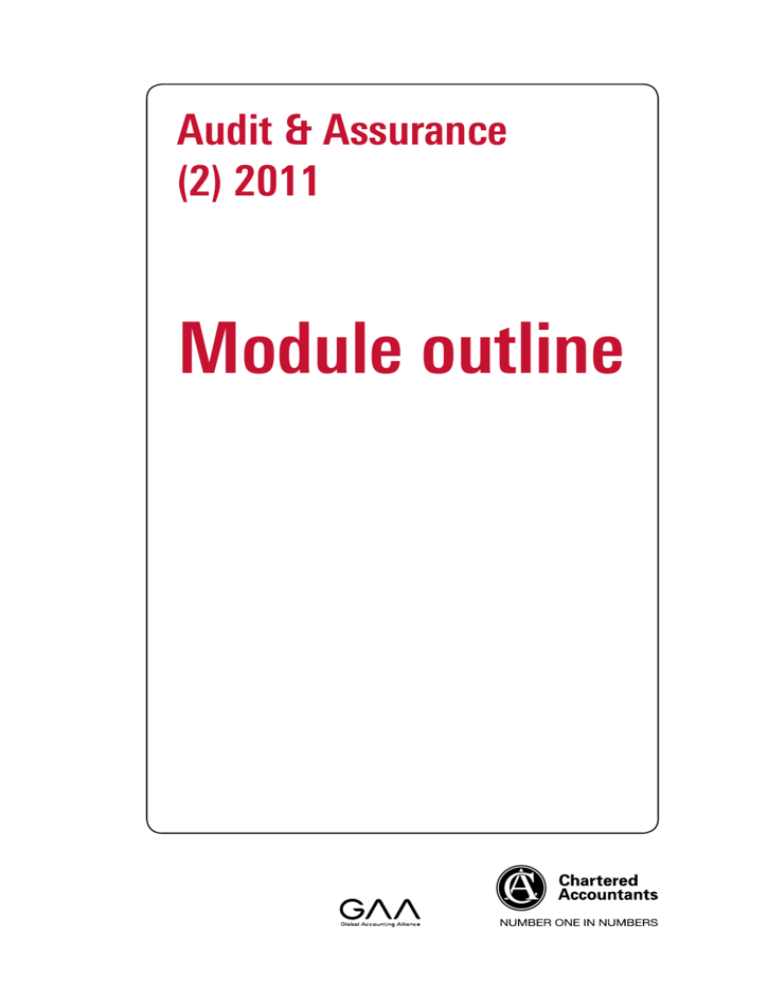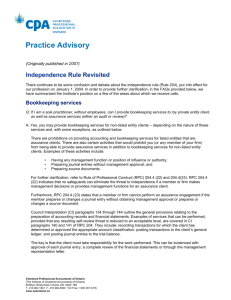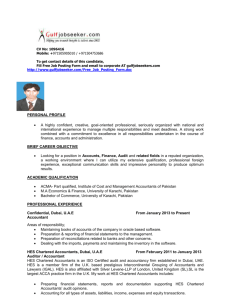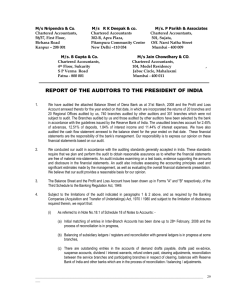Audit & Assurance - The Malaysian Institute Of Certified Public
advertisement

Audit & Assurance (2) 2011 Module outline COMMONWEALTH OF AUSTRALIA Copyright Regulations 1969 WARNING This material has been reproduced and communicated to you by or on behalf of the Institute of Chartered Accountants in Australia pursuant to Part VB of the Copyright Act 1968 (the Act). The material in this communication may be subject to copyright under the Act. Any further reproduction or communication of this material by you may be the subject of copyright protection under the Act. Do not remove this notice. Every reasonable effort has been made to contact relevant copyright holders of published material. Where this has not proved possible, copyright holders are invited to contact the publisher. Copyright owners are entitled to take legal action against persons who infringe their copyright. A reproduction of material that is protected by copyright may be a copyright infringement. Certain dealings with copyright will not constitute an infringement, including: > a reproduction that is a fair dealing under the Copyright Act 1968 (the Act), including a fair dealing for the purposes of research or study; or > a reproduction that is authorised by the copyright owner. It is a fair dealing to make a reproduction for the purposes of research or study, of one or more articles on the same subject in a periodical publication, or, in the case of any other work, of a reasonable portion of a work. In the case of a published work in hard copy form that is not less than 10 pages and is not an artistic work, 10% of the number of pages, or one chapter, is a reasonable portion. In the case of a published work in electronic form only, a reasonable portion is not more than, in the aggregate, 10% of the number of words in the work. More extensive reproduction may constitute fair dealing. To determine whether it does, it is necessary to have regard to the criteria set out in subsection 40(2) of the Act. A court may impose penalties and award damages in relation to offences and infringements relating to copyright material. Higher penalties may apply, and higher damages may be awarded, for offences and infringements involving the conversion of material into digital or electronic form. AAA211 Module outline v3 Contents The Chartered Accountants Program 3 About the Chartered Accountants Program 3 Objectives of the Program 4 Learning & Assessment Guide (LAG) 4 Audit & Assurance (AAA) 5 Module objectives 5 Assumed knowledge 6 Time allocation 6 Assessment 6 Candidate Learning Pack (CLP) 6 myCA 7 Focus sessions 7 Prescribed reading materials 7 Additional resources 7 Audit & Assurance (2) 2011 • Module Overview 1 2 Module Overview • Audit & Assurance (2) 2011 The Chartered Accountants Program About the Chartered Accountants Program The Chartered Accountants Program (the Program) is the formal educational requirement for membership of the Institute of Chartered Accountants in Australia (the Institute). The Institute is the only Australian professional accounting body recognised by the major accounting bodies worldwide, and is a founding member of the international accounting coalition, the Global Accounting Alliance (GAA). The GAA was formed in November 2005 and is an alliance of leading professional accountancy bodies in significant capital markets. It was created to promote quality services, share information and collaborate on important international issues. The GAA works with national regulators, governments and stakeholders, through member-body collaboration, articulation of consensus views, and working in collaboration where possible with other international bodies, especially the International Federation of Accountants (IFAC). The GAA facilitates a co-operation between 11 of the world’s leading professional accounting organisations: > The American Institute of Certified Public Accountants (AICPA) > Canadian Institute of Chartered Accountants (CICA) > Hong Kong Institute of Certified Public Accountants (HKICPA) > Institute of Chartered Accountants in Australia (ICAA) > Institute of Chartered Accountants in England and Wales (ICAEW) > Chartered Accountants Ireland (ICAI) > Institute of Chartered Accountants of Scotland (ICAS) > The Japanese Institute of Certified Public Accountants (JICPA) > New Zealand Institute of Chartered Accountants (NZICA) > South African Institute of Chartered Accountants (SAICA) > Institut der Wirtschaftsprüfer in Deutschland e.V. (IDW). These organisations represent over 775,000 of the world’s leading professional accountants in over 165 countries from around the globe. The Chartered Accountants Program is also recognised as a Graduate Diploma * by higher education authorities in Australia. Successful completion of the Program and the subsequent awarding of a Graduate Diploma provide candidates with substantial exemptions for Masters programs in many Australian universities. The Grad Dip CA comprises the following five modules: 1. Taxation (TAX) 2. Audit & Assurance (AAA) 3. Management Accounting & Analysis (MAA) 4. Financial Accounting & Reporting (FIN) 5. Ethics & Business Application (EBA). * Applicable only to candidates who successfully complete all five modules of the CA Program developed by the Institute. Audit & Assurance (2) 2011 • Module Overview 3 Of the five modules, the first four are technical modules and can be undertaken in any order. The final module, Ethics & Business Application (EBA), focuses on ethics and corporate governance as well as consolidating the learning from the four technical modules. Modules are not undertaken concurrently. Figure 1: Five Program Modules On successful completion of EBA, candidates will be awarded the Grad Dip CA and will then also be eligible to apply for membership with the Institute. Objectives of the Program The Program is designed to equip candidates with the knowledge, skills and values identified as essential in a Chartered Accountant. These have been expanded into the following 10 attributes: Knowledge > informed about the latest international, disciplinary and business knowledge Skills > innovative problem solvers > forward-thinking change managers > technology-literate > collaborative team workers > capable communicators of shared understandings Values > service-oriented > ethical > professional > reflective about their own knowledge, skills and values Developing these attributes in a holistic manner is an integral feature of the Program. Learning & Assessment Guide (LAG) Additional information about the Program can be found in the Chartered Accountants Program Learning & Assessment Guide (LAG) in the candidate section of myCA. The LAG contains comprehensive information about: > Policies and regulations > Code of academic conduct > Regional offices and key contacts > Learning resources 4 Module Overview • Audit & Assurance (2) 2011 >Assessment >Referencing > Further assistance and support. Candidates can access myCA via <charteredaccountants.com.au> or, alternatively, <myCA.blackboard.com>. Audit & Assurance (AAA) This module explains the framework for auditing and assurance. Broadly, the four units examine the following areas: > Unit 1: Planning the audit – The process for the audit of a general purpose financial report – Accounting Professional and Ethical Standards Board statements, audit regulations from the Corporations Act 2001 and case law – Australian Auditing Standards: Introduction – Overall responsibilities in conducting the audit – Risk assessment (planning) > Unit 2: Conducting the audit – The risk response – Using the work of others > Unit 3: Audit evidence, evaluation, reporting and internal audit – Evaluation of audit evidence – Formulating audit opinions and reporting considerations – Role and purpose of the internal auditor > Unit 4: Other aspects of the audit and assurance framework – Other assurance engagements – Public sector reporting and accountability environment – The role of the external auditor in the public sector – The future of assurance. Module objectives The overall objective of AAA is for candidates to develop skills which will enable them to: > plan, perform and report on assurance engagements in a professional manner, and > use professional and ethical judgement in applying relevant legal and professional pronouncements to all stages of a given assurance engagement. Audit & Assurance (2) 2011 • Module Overview 5 Assumed knowledge Apart from a strong undergraduate knowledge of auditing, it is also assumed that you have the following: > a good understanding of financial accounting and preparation of general purpose financial reports > a basic understanding of Australian Accounting Standards (AASBs) > a basic understanding of Australian Auditing Standards (ASAs) > a good understanding of standard business cycles and processes, and how they are accounted for, including: – sales – how a sale is initially recorded in an entity’s accounting system, and then how it flows through the system; debits and credits recorded when the sale is a cash sale; debits and credits that are recorded when the sale is on credit – credit notes – how credit notes are recorded and their impact on the accounting system of an entity on sales and accounts receivable balances – revenue – how revenue from a sale is recorded in an entity’s accounts (immediately or over a period of time) – accounts receivable/debtors – where a sale is made on credit, how the accounts receivable that results from that sale is dealt with by an entity and its accounting system; recording the accounts receivable; recording the provision for doubtful debts; writing off the accounts receivable balance if the receivable balance is not collected – purchases – how the purchase of a good or service by an entity is recorded in an entity’s accounting system, and then how it flows through the system; how debits and credits are recorded when a purchase is made using cash or on credit – accounts payable/creditors – where a purchase is made on credit, how the accounts payable that results from that purchase is dealt with by an entity and its accounting system; recording the accounts payable; recording the payment of the accounts payable balance – inventory – having a basic understanding that when items are purchased for manufacture by an entity, that those items go through the entity’s inventory and COGS (cost of goods sold) accounts rather than being recorded directly in expenses – expenses – how items purchased through the accounts payable system end up being recorded in the expense accounts of an entity; how items end up being recorded in expense accounts from sources outside of the accounts payable subledger or system – payroll – a basic understanding of the components of payroll and how it is all recorded by an entity (e.g. gross salary, superannuation contributions, workers’ compensation payments, payroll tax, and PAYG payments); how accounting for payroll is impacted if payments are made in cash versus via electronic transfer or cheques – property, plant and equipment (PP&E) – a basic understanding of how items of PP&E are recorded by an entity and how associated depreciation is recorded to the entity’s expense accounts, and where applicable, how impairments of PP&E are recorded 6 Module Overview • Audit & Assurance (2) 2011 – intangible assets, impairment and amortisation – a basic understanding of how intangible assets are recorded in an entity’s accounts, when and how the principles of amortisation are to be applied and how the impairment of intangible assets is recorded > a good understanding of how each of the accounting cycles/sub-ledgers, outlined above, feed into the ultimate preparation of an entity’s financial statements > a good understanding of the role and importance of auditing in providing investors with independent verification of general purpose financial reports. Time allocation The expected workload for this module is approximately 120 hours. The breakdown of the 120 hours is approximately as follows: Number Hours per unit Hours of work 4 units 23.00 92.00 Focus sessions 4 3.00 12.25* Project 1 n/a 12.50 Exam (including 15 minutes reading time) 1 n/a 3.25 CLP reading, activities, myCA participation 120.00 * The first focus session has an additional 15 minutes for the welcome and introductions. This is only a guide, depending on various factors and circumstances, and does not include time that candidates allocate to studying for the final exam. Assessment The assessment components are outlined below: > Project – 20% > Four focus sessions – 10% (attendance is compulsory) > Final examination – 70%. Assessment component Contribution to final marks Details Project 20% An individual project submitted between Focus Session 2 and Focus Session 3 Focus sessions 10% Attendance at focus sessions is compulsory. Each of the four focus sessions will include: > Block 1 – Unit review > Block 2 – Candidate facilitation/presentation > Block 3 – Comprehensive activity review > Block 4 – Exam Practice Question (EPQ) review and recap Final examination 70% Any element of the syllabus may be covered in four compulsory multi-part written questions (three (3) hours plus 15 minutes reading time) To pass the module, you must pass the exam (achieve 50% or more of the available marks), pass the module overall and attend all four focus sessions. This is because each assessment component examines different combinations of the attributes cultivated by Audit & Assurance (2) 2011 • Module Overview 7 the Program. The exam is also the only assessment piece performed within stringent individual conditions, guaranteeing the assessment of the knowledge, skills and values built by the Program. Candidate Learning Pack (CLP) The CLP is the primary learning resource and contains comprehensive learning material for all four units of study, including worked examples and activities. Candidates can work through the CLP either independently or in collaboration with their colleagues or mentors. myCA This is a web-based learning portal which is used to provide announcements and study material to candidates, as well as access to a candidate peer discussion forum. Focus sessions The focus sessions follow the same path as the module, that is, with content taken from the relevant unit. Marks have been reintroduced to focus sessions (starting from Term 2, 2011) for each of the four technical modules (not for the EBA module). Marks will be released to candidates prior to the final exam. For more information on how the marks will be awarded and their breakdown, please see the Learning & Assessment Guide (LAG) on myCA. Activity solutions (except for those reviewed in focus sessions) will be released at commencement. The solutions to activities for review and the comprehensive activity solution will be released on myCA on the last Friday of the relevant focus session week. All the EPQ solutions will be released on myCA after the final focus session. Please check the Chartered Accountants Program timetable for the focus session week dates. Prescribed reading materials The required reference for AAA is: > The Institute of Chartered Accountants in Australia, Auditing and assurance handbook 2011, John Wiley & Sons Australia, Ltd, Milton, Qld Additional resources The following material will also provide additional support for candidates and will be referred to in the CLP: > copies of two past exam papers, including solutions and examiners’ feedback > Accounting & auditing news today (ANT), available online at <charteredaccountants. com.au> 8 Module Overview • Audit & Assurance (2) 2011 > Gay, G and Simnett, R 2009, Auditing and assurance services in Australia, 4th edn, McGraw-Hill, Sydney > Roebuck, P and Martinov-Bennie, N 2010, Case studies in auditing and assurance, 5th edn, LexisNexis Butterworths, Sydney > Chandler, J 2009, Auditing road map: A simple guide to the auditing process, Centennial Books, Sydney. Available by contacting jay@capstonebia.com > The Institute of Chartered Accountants in Australia 2010, Australian Audit Manual and Toolkit 2010, Using Clarity Standards (Australian Audit Manual), October 2010, available online on myCA. With the exception of the Auditing road map (available for purchase at jay@capstonebia.com), the above recommended texts are available for purchase from the UNSW bookshop. Audit & Assurance (2) 2011 • Module Overview 9







